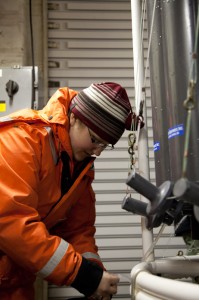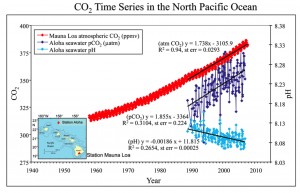The key to getting research accomplished both in the field and in the lab is a good team. Dr. Jeremy Mathis has put together a stellar group of young scientists in his Ocean Acidification Research Center (OARC) at University of Alaska-Fairbanks. I am having the pleasure of working with and learning from two of his current students while on board, Jessica Cross, a PhD student, and Stacy Reisdorph, a Masters student. Jessica and I sat down for a little chemistry lesson last night before she went on watch and I learned all about her research and her path to studying ocean chemistry…

Jessica takes a water sample after a deep cast
The USCGC Healy has become like a second home to Jessica as she has spent, in the past two years, more than 200 days aboard sailing mostly in the Bering Sea in order to collect data for her PhD research. A few years ago, when Jessica was a freshman at Rhodes College in Tennessee, she would never have imagined herself studying chemistry, let alone oceanography, as her first passions were books and writing. Now entering her fourth year of her PhD, she can’t imagine doing anything else and shows giddy excitement for ocean chemistry and endless enthusiasm for her work. Spending all of those days at sea after her initial coursework gave her a thorough understanding of basic oceanographic concepts and she explains how there is no better way to learn than to be at sea with other scientists who are willing to share their knowledge and experience. In the short time I have been at sea with Jessica, it is clear that she knows how to get work done efficiently and enjoys collecting samples for not just her own research but for the lab as a whole.
Jessica’s work focuses on ocean acidification in the Bering Sea as part of the Bering Ecosystem Study project (BEST). (Note: GOE participated in a BEST cruise in April/May 2008 in the Bering Sea…see Bering Sea Ice Expedition for more details) Jessica has been collecting and analyzing water samples from the Bering Sea for Dissolved Organic Carbon (DIC) and Alkalinity in order to determine the pH (measurement of acidity) of the water. Armed with this knowledge, she then can figure out the carbonate saturation state that is vital to the shell-building animals of the ocean, and in the Bering Sea in particular, the King Crab. The Bering Sea is a particularly interesting system, as is the Arctic Ocean, because of the variety of water mixing from river outflows, deepwater upwelling, surface water and ice melt creating an acidic environment in its natural state of equilibrium due to these various natural inflows of carbon dioxide. The question for the present and the future, is whether the increased anthropogenic carbon dioxide, and in turn the decreased pH in the Bering Sea, will affect the animals’ ability to adapt to their changing environment? Jessica seeks to quantify these changes and her excitement for the work is contagious.





